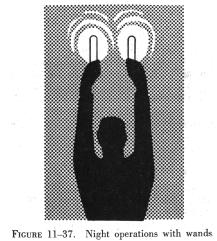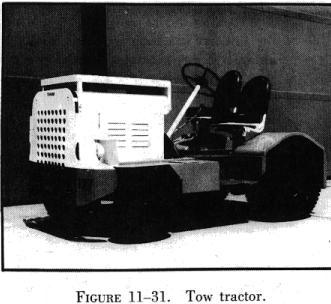MOVEMENTOFAIRCRAFT
MOVEMENT OF AIRCRAFT
General
Movement of large aircraft on an airport and about the flight line and
hangar is usually accomplished by towing with a tow tractor (sometimes
called a "mule or tug"). In the case of small aircraft, most moving is
accomplished by hand, by pushing on certain areas of the aircraft surface.
Aircraft may also be taxied about the flight line, but usually only by
certain qualified persons.
Towing of Aircraft
Towing aircraft can be a hazardous operation, causing damage to the
aircraft and injury to personnel, if done recklessly or carelessly. The
following paragraphs outline the general procedure for towing aircraft;
however, specific instructions for each model of aircraft are detailed
in the manufacturer's maintenance instructions and should be followed in
all instances.
Before the aircraft to be towed is moved, a qualified man must be in
the cockpit to operate the brakes in case the tow bar should fail or become
unhooked. The aircraft can then be stopped, preventing possible damage.
Some types of tow bars available for general use (figure
11-30) can be used for many types of towing operations. These bars
are designed with sufficient tensile strength to pull most aircraft, but
are not intended to be subjected to torsional or twisting loads. Although
many have small wheels that permit them to be drawn behind the towing vehicle
going to or from an aircraft, they will suffer less damage and wear if
they are loaded aboard the vehicle and hauled to the aircraft. When the
bar is attached to the aircraft, all the engaging devices should be inspected
for damage or malfunction before moving the aircraft.
Some tow bars are designed for towing various types of aircraft; however,
other special types can be used on a particular aircraft only. Such bars
are usually designed and built by the aircraft manufacturer.
| When towing the aircraft, the towing vehicle speed must
be reasonable, and all persons involved in the operation must be alert.
When the aircraft is stopped, the brakes of the towing vehicle alone
should not be relied upon to stop the aircraft. The man in the cockpit
should coordinate the use of the aircraft brakes with those of the towing
vehicle. A typical tow tractor (or tug) is shown in figure 11-31.
The attachment of the tow bar will vary on different types of aircraft.
Aircraft equipped with tailwheels are generally towed forward by attaching
the tow bar to the tow rings on the main landing gear. In most cases it
is permissible to tow the aircraft in reverse by attaching the tow bar
to the tailwheel axle. Anytime an aircraft equipped with a tailwheel is
towed, the tailwheel must be unlocked or the tailwheel locking mechanism
will be damaged or broken. |
|
Aircraft equipped with tricycle landing gear are generally towed forward
by attaching a tow bar to the axle of the nosewheel. They may also be towed
forward or backward by attaching a towing bridle or specially designed
towing bar to the towing lugs on the main landing gear. When an aircraft
is towed in this manner, a steering bar is attached to the nosewheel to
steer the aircraft.
The following towing and parking procedures are typical of one type
of operation. They are examples, and not necessarily suited to every type
of operation. Aircraft ground handling personnel should be thoroughly familiar
with all procedures pertaining to the types of aircraft being towed and
local operating standards governing ground handling of aircraft. Only competent
persons properly checked out should direct an aircraft towing team.
1. The towing vehicle driver is responsible for operating his vehicle
in a safe manner and obeying emergency stop instructions given by any team
member.
2. The person in charge should assign team personnel as wing walkers.
A wing walker should be stationed at each wingtip in such a position that
he can ensure adequate clearance of any obstruction in the path of the
aircraft. A tail walker should be assigned when sharp turns are to be made,
or when the aircraft is to be backed into position.
3. A qualified person should occupy the pilot's seat of the towed aircraft
to observe and operate the brakes as required. When necessary, another
qualified person is stationed to watch and maintain aircraft hydraulic
system pressure.
4. The person in charge of the towing operation should verify that,
on aircraft with a steerable nosewheel, the locking scissors are set to
full swivel for towing. The locking device must be reset after the tow
bar has been removed from the aircraft. Persons stationed in the aircraft
should not attempt to steer or turn the nosewheel when the tow bar is attached
to the aircraft.
5. Under no circumstances should anyone be permitted to walk or ride
between the nosewheel of an aircraft and the towing vehicle, nor ride on
the outside of a moving aircraft or on the towing vehicle. In the interest
of safety, no attempt to board or leave a moving aircraft or towing vehicle
should be permitted.
6. The towing speed of the aircraft should not exceed that of the walking
team members. The aircraft's engines usually are not operated when the
aircraft is being towed into position.
7. The aircraft brake system should be charged before each towing operation.
Aircraft with faulty brakes should be towed into position only for repair
of brake systems, and then only with personnel standing by ready with chocks
for emergency use. Chocks must be immediately available in case of an emergency
throughout any towing operation.
8. To avoid possible personal injury and aircraft damage during towing
operations, entrance doors should be closed, ladders retracted, and gear
downlocks installed.
9. Prior to towing any aircraft, check all tires and landing gear struts
for proper inflation. (Inflation of landing gear struts of aircraft in
overhaul and storage is excluded.)
10. When moving aircraft, do not start and stop suddenly. For added
safety, aircraft brakes must never be applied during towing except in emergencies,
and then only upon command by one of the tow team members.
11. Aircraft should be parked in specified areas only. Generally, the
distance between rows of parked aircraft should be great enough to allow
immediate access of emergency vehicles in case of fire, as well as free
movement of equipment and materials.
12. Wheel chocks should be placed fore and aft of the main landing gear
of the parked aircraft.
13. Internal or external control locks (gust locks or blocks) should
be used while the aircraft is parked.
14. Prior to any movement of aircraft across runways or taxiways, contact
the airport control tower on the appropriate frequency for clearance to
proceed.
15. An aircraft should not be parked in a hangar without immediately
being statically grounded.
Taxiing Aircraft
As a general rule, only rated pilots and qualified airframe and powerplant
technicians are authorized to start, run up, and taxi aircraft. All taxiing
operations should be performed in accordance with applicable local regulations.
Figure 11-32 contains the standard taxi light signals used by control towers
to control and expedite the taxiing of aircraft. Refer to the following
section, "Taxi Signals," for detailed instructions on taxi signals and
related taxi instructions.

Taxi Signals
| Many ground accidents have occurred as a result of improper
technique in taxiing aircraft. Although the pilot is ultimately responsible
for the aircraft until the engine is stopped, a taxi signalman can assist
him around the flight line. In some aircraft configurations, the pilot's
vision is obstructed while he is on the ground. He cannot see obstructions
close to the wheels nor under the wings, and has little idea of what is
behind him. Consequently, he depends upon the taxi signalman for directions.
Figure 11-33 shows a taxi signalman indicating his readiness to assume
guidance of the aircraft by extending both arms at full length above his
head, palms facing each other.
The standard position for a signalman is slightly ahead of and in line
with the aircraft's left wingtip. As the signalman faces the aircraft,
the nose of the aircraft is on his left (figure 11-34).
He must stay far enough ahead of the wingtip for the pilot to see him easily.
He should follow a foolproof test to be sure the pilot can see his signals.
If he can see the pilot's eyes, the pilot can see his signals.
Figure 11-35 shows the standard aircraft taxiing
signals published in the Airmen's Information Manual by the Federal Aviation
Administration. It should be emphasized that there are other standard signals,
such as those published by the Armed Forces.
In addition, operating conditions in many areas may call for a modified
set of taxi signals. The signals shown in Figure 11-35
represent a minimum number of the most commonly used signals. Whether this
set of signals or a modified set is used is not the most important consideration,
as long as each flight operational center uses a suitable, agreed upon
set of signals. |

|
Figure 11-36 illustrates some of the most commonly
used helicopter operating signals.
The taxi signals to be used should be studied until the taxi signalman
can execute them clearly and precisely. The signals must be given in such
a way that the pilot cannot confuse their meaning. It should be remembered
that the pilot receiving the signals is always some distance away, and
must often look out and down from a difficult angle. Thus, the signalman's
hands should be kept well separated, and signals should be overexaggerated
rather than risk making indistinct signals. If there is any doubt about
a signal, or if the pilot does not appear to be following the signals,
the "stop" signal should be used and the series of signals begun again.
| The signalman should always try to give the pilot an indication
of the approximate area in which the aircraft is to be parked. The signalman
should glance behind himself often when walking backward to prevent backing
into a propeller or tripping over a chock, fire bottle, tiedown line, or
other obstruction.
Taxi signals are usually given at night with the aid of illuminated
wands attached to flashlights (figure 11-37). Night signals are made in
the same manner as day signals with the exception of the stop signal. The
stop signal used at night is the "emergency stop" signal. This signal is
made by crossing the wands to form a lighted "X" above and in front of
the head. |

|



